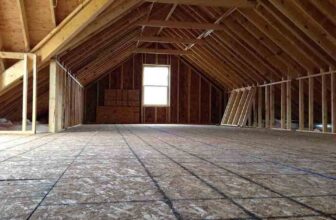
It sneaks up on a lot of homeowners: everything seems fine after a rainstorm, but then you start noticing peeling paint, musty smells, or water spots near the roofline.
By the time you figure out the issue, you’re looking at rotted fascia boards or mold creeping into your attic.
One of the most common—and most overlooked—culprits? Water leaking behind the gutters.
Let’s break it down. We’ll walk through how to spot the signs, what’s actually causing the leaks, and how you can fix it—without throwing your whole weekend (or budget) into chaos.
Table of Contents
Why You Shouldn’t Ignore Leaks Behind Gutters
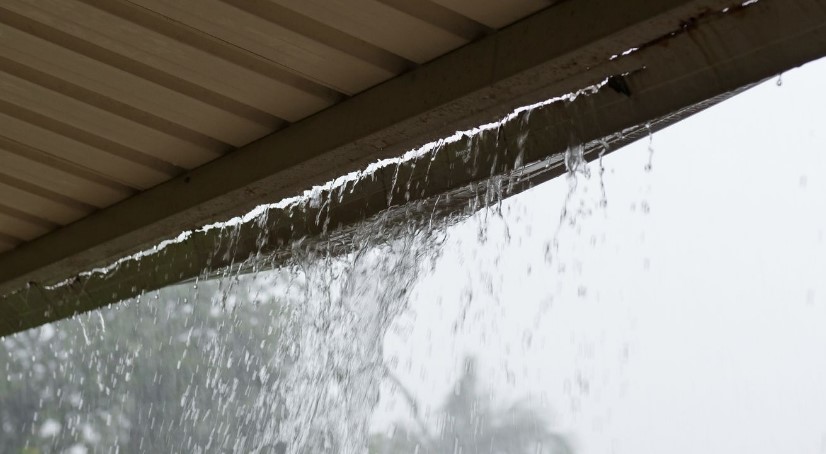
Source: amcoroof.com/Screenshot
Your gutters aren’t just there for show. They’re a functional line of defense between your roof and everything below it—walls, windows, siding, even your foundation.
When rainwater flows down your roof, gutters are supposed to catch and redirect it away from your home.
But when water slips behind the gutters instead of going through them, it opens the door to some serious problems.
Here’s what can happen when that water gets where it’s not supposed to go:
- Wood rot: Fascia and soffit boards can rot over time, especially in older homes.
- Mold growth: Trapped moisture creates an ideal environment for mold—and it doesn’t always stay in the attic.
- Cracked or peeling paint: Both outside and inside, paint can bubble, crack, or peel if moisture is present.
- Structural issues: Water pooling near the foundation can erode soil, cause shifting, or even crack the foundation.
A house built in the ’70s with aging gutters might be more vulnerable than a newer home with seamless gutter systems—but the issue can affect anyone.
Especially in places with frequent rainfall or storms, like the Pacific Northwest or Gulf Coast.
Signs That Water Is Leaking Behind Your Gutters
A leak behind the gutters doesn’t always scream for attention. It’s more of a whisper—until the damage becomes obvious. But if you know what to look for, you can catch the problem early.
| Sign | What It Might Mean |
| Dripping from roof edges | Water may be slipping between the roofline and gutter instead of going through it. |
| Musty smells in the attic or walls | Moisture is seeping in, potentially creating a mold problem. |
| Puddles near the foundation | Gutters aren’t directing water away properly—possibly due to backflow. |
| Visible mold or mildew | Moisture behind walls or near the roofline is encouraging growth. |
| Peeling or cracking paint | Water seepage is causing interior or exterior paint to fail. |
| Water spilling over gutter edges | Could be from clogging—or from water sneaking behind the gutter during rain. |
| Stained siding or concrete | Persistent runoff is leaving marks or causing algae/mildew on exterior surfaces. |
Want a quick way to spot trouble? Watch your home during the next rainstorm. If you see water running down the siding or dripping from behind the gutter, something’s definitely off.
What’s Actually Causing the Leaks?
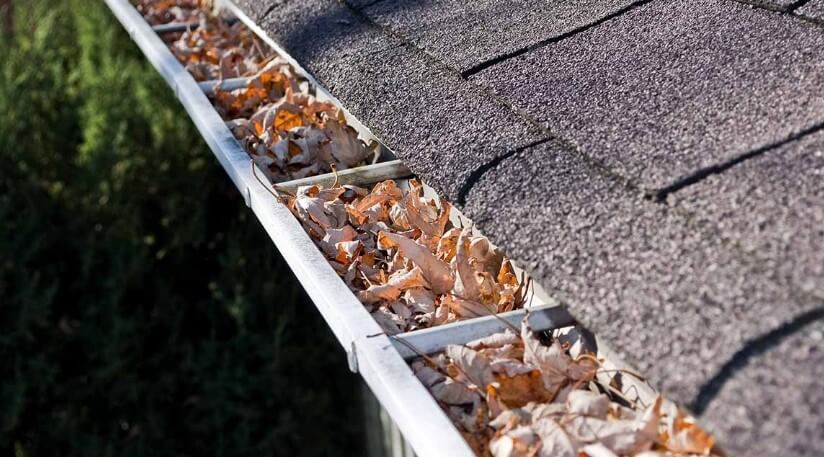
Source: ecroofinginc.com/Screenshot
There’s usually not just one cause—sometimes it’s a combination of age, weather, and a little neglect. But certain culprits pop up more often than others.
1. Poor Installation
One of the most common issues is when gutters are installed without a proper gutter apron or drip edge. These are small metal pieces—usually L-shaped flashing—that guide water from the shingles directly into the gutter. Without them, water can sneak between the gutter and fascia.
Older homes may be missing this entirely. Or the existing metal might be lying too flat to do its job well.
2. Clogged Gutters
Leaves, pine needles, seed pods—you name it. When it builds up in the gutter, water doesn’t have anywhere to go. During a heavy downpour, it can spill over the back and head straight into the fascia board or behind the siding.
Regular maintenance by gutter cleaning specialists can prevent such blockages and ensure proper water flow.
3. Low Roof Pitch
On homes with low-slope roofs (common in ranch-style designs), rainwater doesn’t move as quickly. That slow movement lets water wick back under the shingles and past the drip edge. It’s called capillary action, and it’s sneaky.
4. Damage to Gutters or Fascia
Cracked joints, separated seams, or rust holes can allow water to escape before it reaches the downspouts. Similarly, if the fascia is already damaged or warped, water won’t be guided properly.
5. Loose Hangers or Improper Pitch
If the gutter hangers have pulled away from the fascia, even slightly, it can shift the slope of the gutter. And if water can’t flow properly, it often finds the path of least resistance—over the edge or behind the system entirely.
How to Fix the Problem
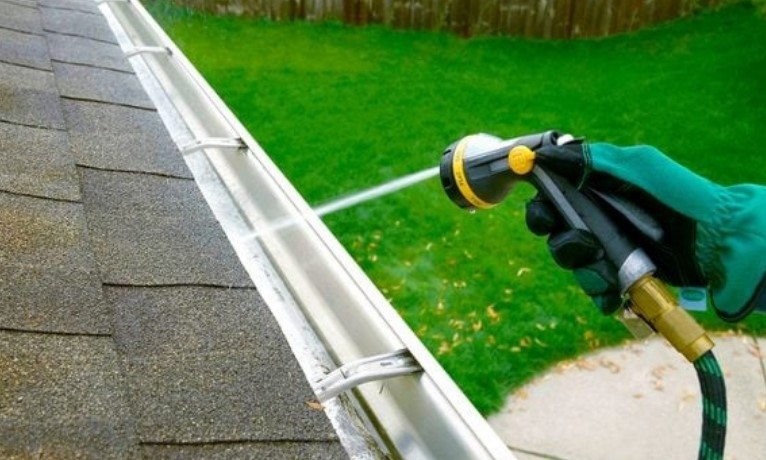
Source: familyhandyman.com/Screenshot
There’s no one-size-fits-all fix. You’ll need to match the solution to the cause. Here’s a quick reference:
| Problem | Solution | Details |
| No drip edge/gutter apron | Install flashing or aprons | L-shaped metal under shingles, over gutter to catch water |
| Low-pitch roof | Add flashing strip under drip edge | Prevents water from wicking backward |
| Cracked or loose gutters | Seal or replace damaged sections | Use waterproof caulk for small holes, replace larger pieces |
| Clogs | Clean and flush with hose, consider guards | Remove debris by hand or scoop; install mesh if clogging is frequent |
| Loose hangers | Refasten or replace hangers | Use new screws; ensure proper pitch (1/4″ drop every 10 feet recommended) |
Step-by-Step Fixes
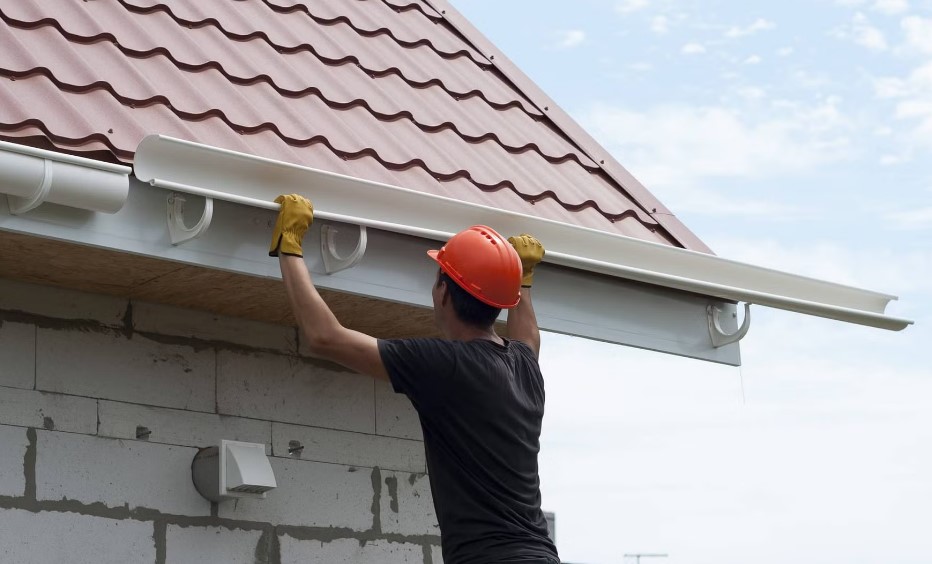
Source: optimole.com/Screenshot
1. Installing a Gutter Apron or Drip Edge
- Gently lift the bottom row of shingles with a pry bar.
- Slide the apron (L-flashing) underneath.
- Nail it into the roof deck using roofing nails.
- Let the lower end rest inside the gutter.
It’s inexpensive—usually under $10 per 10-foot section—and available at most hardware stores.
2. Fixing Low-Pitch Problems with Flashing
- Cut a narrow strip of metal flashing (aluminum or galvanized).
- Slide it under the existing drip edge, letting it extend over the back of the gutter.
- Screw it in place. Avoid caulking—it’s a temporary fix that won’t last in wet conditions.
3. Repairing or Replacing Damaged Gutters
- Clean the affected area with a wire brush.
- For holes or cracks: apply waterproof sealant once the surface is dry.
- For larger damage: cut out the bad section and replace it with matching gutter material, using connectors and sealant at the joints.
4. Cleaning and Maintaining Gutters
- Use a sturdy ladder and a gutter scoop or gloved hands.
- Flush the gutter with a hose afterward to ensure proper flow.
- If debris is a constant problem, install leaf guards or mesh screens.
5. Securing or Adjusting Hangers
- Inspect for sagging or tilting sections.
- Tighten any loose screws or replace bent hangers.
- Check the pitch using a level. Adjust as needed to ensure steady flow toward the downspout.
Pro Tips for Long-Term Prevention
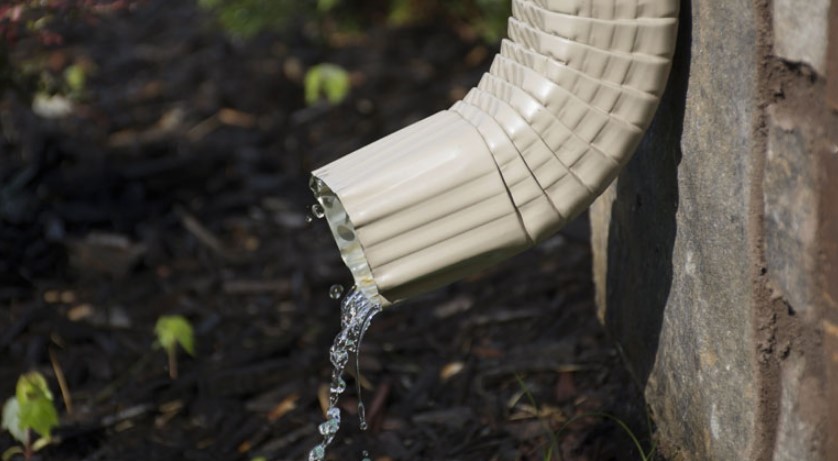
Source: ebyexteriors.com/Screenshot
Staying ahead of leaks is way easier (and cheaper) than fixing water-damaged fascia or repainting walls. Here’s how to stay on top of it:
- Clean your gutters twice a year—spring and fall are the usual seasons, but increase frequency if you live under trees.
- Install gutter guards if you’re tired of the leaf cleanout cycle.
- Walk your home once a season and look for stains, puddles, or peeling paint.
- Test the downspouts during heavy rain—are they moving water away from the foundation?
- Check for hanger separation or warping if you spot sagging gutters.
Even just five minutes after a storm with a flashlight can give you key clues.
Regional and Seasonal Factors
Certain areas are more prone to gutter problems—either because of heavy rainfall, wind-blown debris, or freeze-thaw cycles.
- Pacific Northwest (e.g., Seattle, Portland): Heavy rain and falling debris make gutter maintenance non-negotiable. Biannual cleanings are a must.
- South/Southeast (e.g., Florida, Louisiana): Frequent storms and humidity make mold and fascia damage more likely.
- Midwest/Northeast: Freeze-thaw cycles can loosen fasteners and open seams—be extra careful about pre-winter inspections.
When to Bring in a Pro
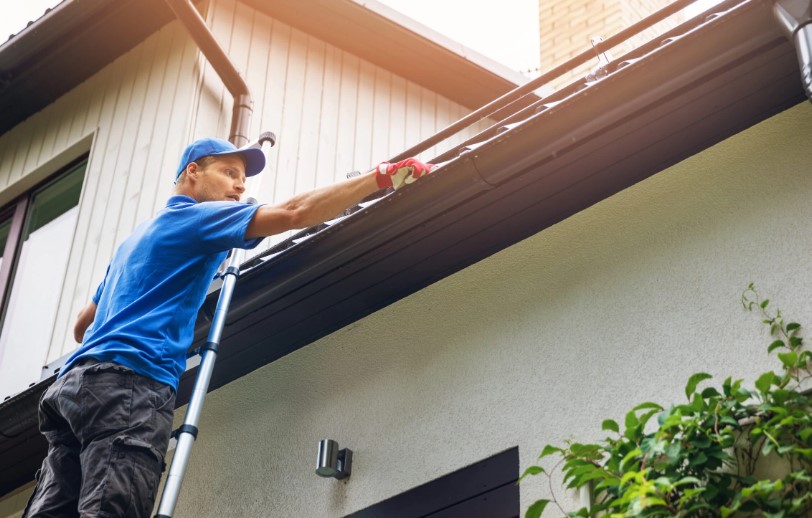
Source: gutterpros.com/Screenshot
You can knock out a lot of this yourself with a ladder, some basic tools, and a little patience. But if you’re looking at widespread fascia rot, separated siding, or gutters that seem beyond repair, it might be time to call someone in.
What a professional might help with:
- Full gutter replacement (especially for seamless systems)
- Fascia board replacement or roof edge repairs
- Diagnosing structural water damage
- Installing gutter guards or rerouting downspouts
In many cases, hiring a pro for a one-time fix is cheaper than letting the damage compound and dealing with a full wall or foundation repair.
Final Thoughts
Water leaking behind your gutters might not sound like a big deal at first—but the damage it causes can add up fast. If you’ve seen peeling paint, mold near the ceiling, or puddles by your home’s edge, it’s time to act.
The good news? Most fixes are well within reach. Whether it’s installing a gutter apron, sealing a crack, or just keeping up with cleanings, small steps can go a long way toward protecting your home.
If you’re not sure what’s going on or the issue keeps coming back, don’t be afraid to bring in an expert. A quick inspection today can save you from big headaches tomorrow.





